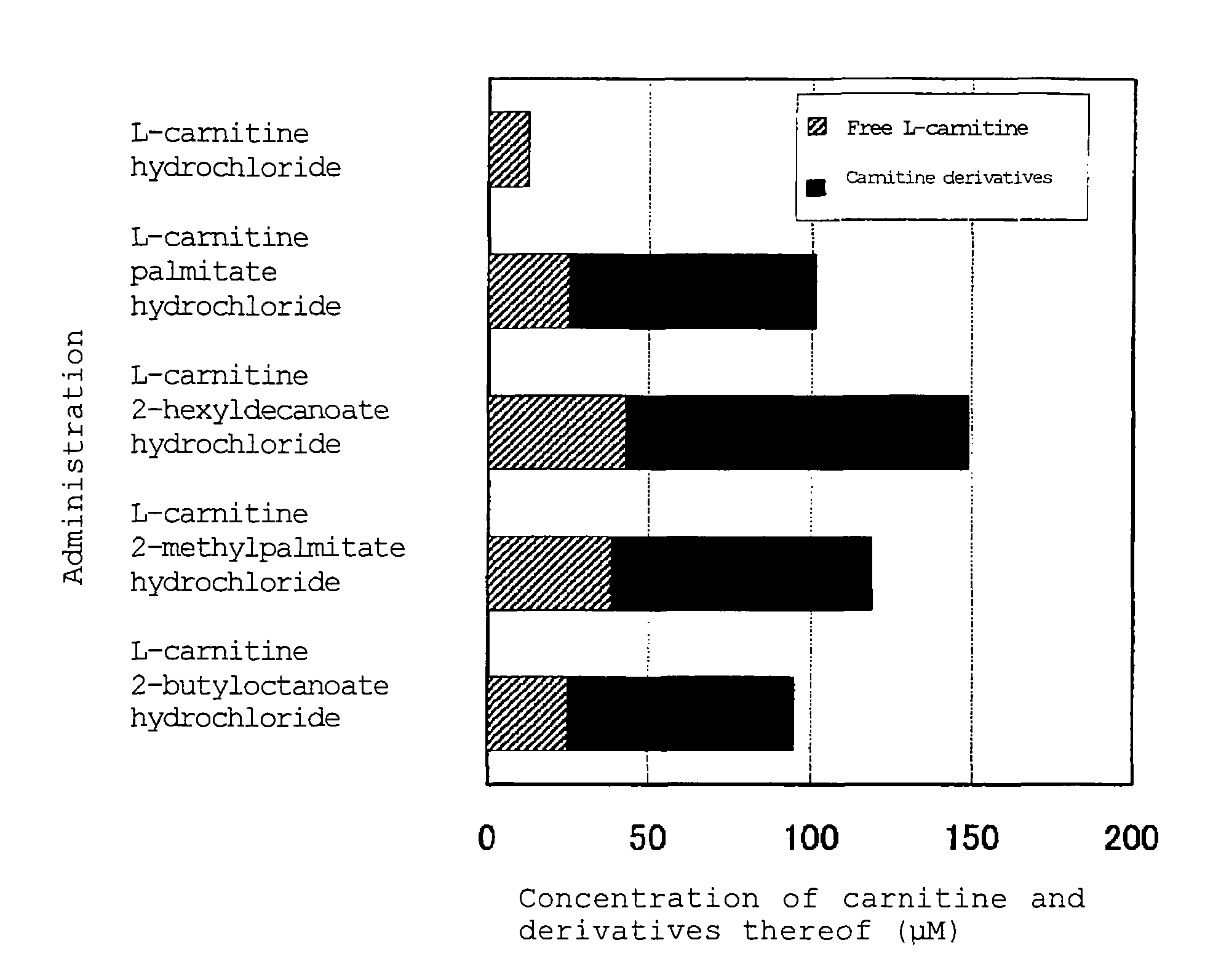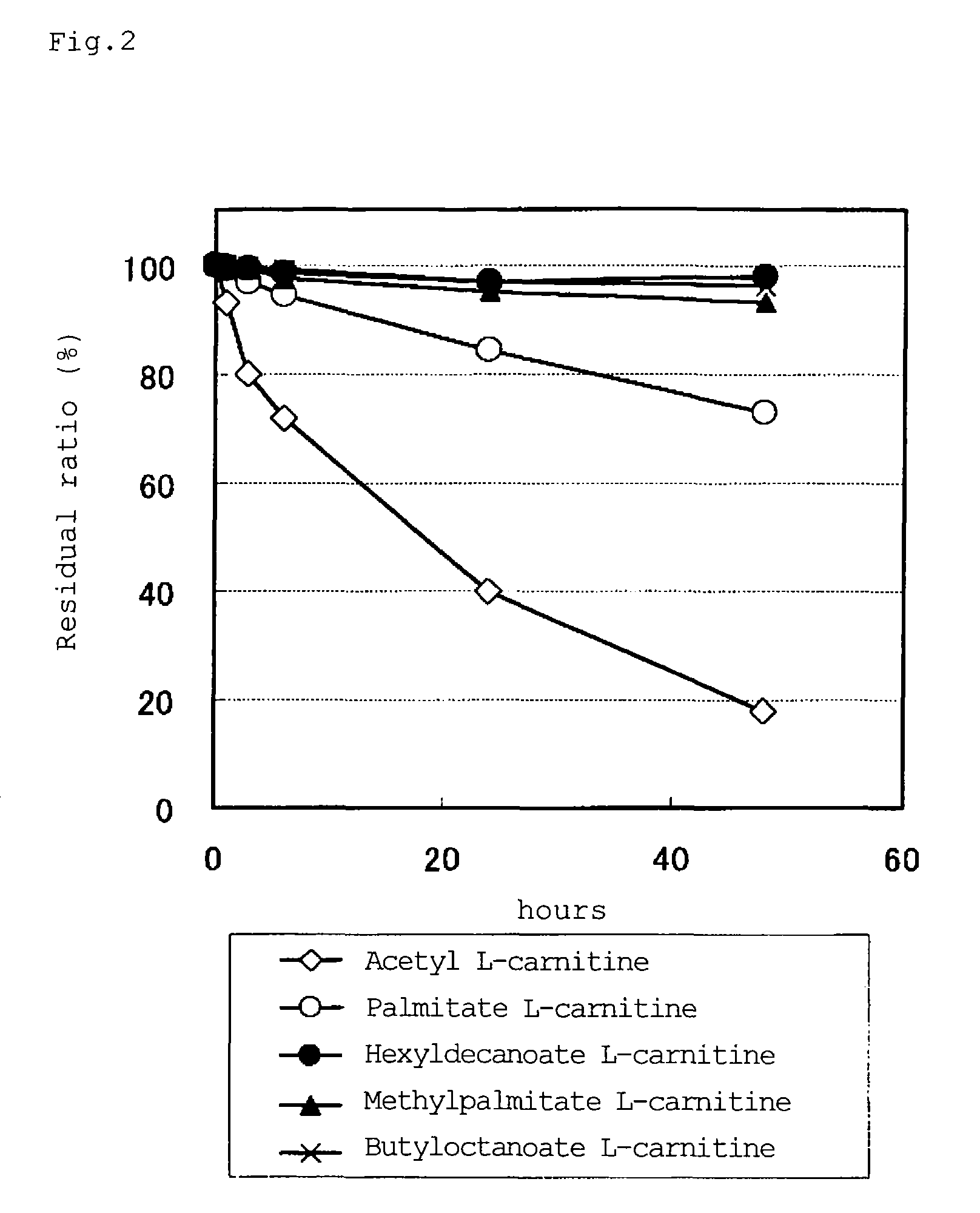Carnitine derivative, salt thereof, external skin preparation and cosmetic material
a technology of carnitine and salt, applied in the field of external skin preparations and cosmetics, can solve the problems of many cosmetic and qol (quality of life) problems, cellulite formation, acne, etc., and achieve the effects of stimulating lipid metabolism, skin affinity, percutaneous absorption properties, and stimulating lipid metabolism
- Summary
- Abstract
- Description
- Claims
- Application Information
AI Technical Summary
Benefits of technology
Problems solved by technology
Method used
Image
Examples
synthetic example 1
Synthesis of L-carnitine 2-hexyldecanoate hydrochloride
[0182]In an ice bath, 45.6 g (0.283 mol) of L-carnitine was dissolved in 150 ml of trifluoroacetic acid. To the resultant solution, 116.6 g (0.425 mol) of 2-hexyldecanoic acid chloride was added dropwise over a period of 10 minutes, followed by heating and stirring at 80° C. for 4 hours. The solvent was distilled off under reduced pressure. The resultant dark brown oily substance weighing 264.6 g was washed with 200 ml of n-hexane three times, and 200 ml of a black oily substance was collected. 3.0 g of the oily substance was subjected to extraction with 20 ml of ethanol, 30 ml of n-butanol, and 60 ml of water. The organic phase obtained was washed with 60 ml of water, and with a mixture of 20 ml of ethanol and 60 ml of water. The organic phase was washed with 60 ml of water, collected and dried. Distilling away the solvent resulted in 2.0 g of L-carnitine 2-hexyldecanoate hydrochloride.
[0183]The structure of the compound obtain...
synthetic example 2
Synthesis of L-carnitine 2-methylpalmitate hydrochloride
[0209]In an ice bath, 45.6 g (0.283 mol) of L-carnitine was dissolved in 150 ml of trifluoroacetic acid. To the resultant solution, 122.4 g (0.425 mol) of 2-methylpalmitic acid chloride was added dropwise over a period of 10 minutes, followed by heating and stirring at 80° C. for 4 hours. The solvent was distilled off under reduced pressure. The resultant dark brown oily substance weighing 278.0 g was washed with 200 ml of n-hexane three times, and 200 ml of a black oily substance was collected. 3.0 g of the oily substance was subjected to extraction with 20 ml of ethanol, 30 ml of n-butanol, and 60 ml of water. The organic phase obtained was washed with 60 ml of water, and with a mixture of 20 ml of ethanol and 60 ml of water. The organic phase was washed with 60 ml of water, collected and dried. Distilling away the solvent resulted in 2.2 g of L-carnitine 2-methylpalmitate hydrochloride.
[0210]The structure of the compound obt...
synthetic example 3
Synthesis of L-carnitine 2-butyloctanoate hydrochloride
[0214]In an ice bath, 45.6 g (0.283 mol) of L-carnitine was dissolved in 150 ml of trifluoroacetic acid. To the resultant solution, 92.7 g (0.425 mol) of 2-butyloctanoic acid chloride was added dropwise over a period of 10 minutes, followed by heating and stirring at 80° C. for 4 hours. The solvent was distilled off under reduced pressure. The resultant dark brown oily substance weighing 250.0 g was washed with 200 ml of n-hexane three times, and 200 ml of a black oily substance was collected. 3.0 g of the oily substance was subjected to extraction with 20 ml of ethanol, 30 ml of n-butanol, and 60 ml of water. The organic phase obtained was washed with 60 ml of water, and with a mixture of 20 ml of ethanol and 60 ml of water. The organic phase was washed with 60 ml of water, collected and dried. Distilling away the solvent resulted in 1.6 g of L-carnitine 2-butyloctanoate hydrochloride.
[0215]The structure of the compound obtaine...
PUM
| Property | Measurement | Unit |
|---|---|---|
| volume | aaaaa | aaaaa |
| pH | aaaaa | aaaaa |
| fluorescent wavelength | aaaaa | aaaaa |
Abstract
Description
Claims
Application Information
 Login to View More
Login to View More - R&D
- Intellectual Property
- Life Sciences
- Materials
- Tech Scout
- Unparalleled Data Quality
- Higher Quality Content
- 60% Fewer Hallucinations
Browse by: Latest US Patents, China's latest patents, Technical Efficacy Thesaurus, Application Domain, Technology Topic, Popular Technical Reports.
© 2025 PatSnap. All rights reserved.Legal|Privacy policy|Modern Slavery Act Transparency Statement|Sitemap|About US| Contact US: help@patsnap.com



